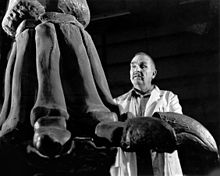James A. Jensen
James Alvin Jensen (born August 2, 1918 in Leamington , Utah , † December 14, 1998 in Provo , Utah) was an American paleontologist specializing in dinosaurs . He was nicknamed Dinosaur Jim .
Life
Jensen, who did not graduate from high school , grew up in the now-abandoned gold rush town of Mercur, Utah, and moved to Alaska with his wife, whom he married in 1941. With the beginning of the Second World War he was involved as a welder, among other things, in the construction of the Hanford reactor and in the reconstruction of Pearl Harbor. He then worked in a wide variety of craft professions (including sculptor) in Utah and Alaska (as dock worker), where he also worked as taxidermist and came into contact with the paleontologist Arnie Lewis. From 1956 he was employed as a taxidermist by Alfred Sherwood Romer and Arnie Lewis at the Museum of Comparative Zoology at Harvard University and was involved in dinosaur excavation campaigns. There he also developed an assembly technique for dinosaur skeletons in museums in the late 1950s, which hides the support elements (free-standing assembly, support elements integrated into the bones or hidden by them) and led to significant weight reductions. A Kronosaurus skeleton was first assembled in 1957. It became the model for most of the assemblies of dinosaurs in museums. From 1961 he was at Brigham Young University in Utah, for which he excavated the Morrison Formation in the rich dionosaur site Dry-Mesa Quarry in western Colorado (from 1972). The BYU Museum of Paleontology was set up around the finds from 1976 (the football stadium served as a repository for a long time, and in 2009 it was opened in new exhibition halls). Jensen organized a network of amateur paleontologists for his search. He also dug in Argentina and Antarctica.
He first described Cathetosaurus , Supersaurus (partial finds also as Dystylosaurus and Ultrasaurus ) and Torvosaurus (with Peter Galton ).
In 1971 he received an honorary doctorate from Brigham Young University.
Web links
Individual evidence
- ^ Museum of Paleontology. Retrieved July 1, 2019 .
| personal data | |
|---|---|
| SURNAME | Jensen, James A. |
| ALTERNATIVE NAMES | Jensen, James Alvin (full name); Dinosaur Jim (nickname) |
| BRIEF DESCRIPTION | American paleontologist |
| DATE OF BIRTH | August 2, 1918 |
| PLACE OF BIRTH | Leamington , Utah |
| DATE OF DEATH | December 14, 1998 |
| Place of death | Provo , Utah |
